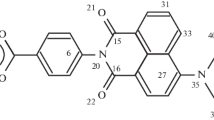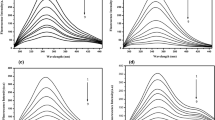Abstract
In partition experiments in aqueous two-phase systems composed of 10% (w/w) dextran (Mr=500000) and 7.510 (w/w) poly(ethylene-glycol) (Mr=6000) prealbumin and albumin are directed into the dextran-rich phase. Addition of Remazol Yellow GGL covalently bound to poly(ethylene-glycol) causes a transfer of prealbumin and albumin into the poly(ethylene-glycol)-rich phase. This indicates an interaction of both proteins with the dye (affinity phase partitioning).
The affinity partitioning effect on prealbumin is markedly increased by an excess of monomeric albumin. This points to an interaction of the two proteins in the presence of the dye.
Binding of free Remazol Yellow GGL to prealbumin and albumin was investigated by means of equilibrium dialysis and difference spectroscopy. In respect to prealbumin equilibrium dialysis resulted in the binding of four molecules of the dye to two classes of binding sites with dissociation constants of KH=3.3 IM and KL=258 µM respectively whereas albumin was found to bind eight molecules of the dye to two classes of binding sites with KH=5.8 µM and KL=282 µM. Similar binding stoichiometries were found by difference spectroscopy.
By application of difference spectroscopy and affinity phase partitioning thyroxine and triiodothyronine known as natural ligands of prealbumin and albumin were found to compete with Remazol Yellow GGL for the dye binding sites of the proteins.
Similar content being viewed by others
References
Kopperschläger G, Boehme H-J, Hofmann E: Cibacron Blue F3G-A and related dyes as ligands in affinity chromatography. In: Fiechter A (ed). Advances in Biochemical Engineering. Springer, Berlin, Heidelberg, New York, 1982, pp 101–138.
Subramanian S: Dye-ligand affinity chromatography: the interaction of Cibaron Blue F3G-A with proteins and enzymes. CRC Crit Rev Biochem 16:169–205, 1984.
Boehme H-J, Kopperschldger G, Schulz J, Hofmann E: Affinity chromatography of phosphofructokinase using Cibacron Blue F3G-A. J Chromatogr 69:209–214, 1972.
Travis J, Pannell R: Selective removal of albumin from plasma by affinity chromatography. Clin Chim Acta 49:49–52, 1973.
Birkenmeier G, Kopperschläger G: Application of dyeligand chromatography to the isolation of α-1-proteinase inhibitor and α-1-acid glycoprotein. J Chromatogr 235:237–248, 1982.
Virca GD, Travis J, Hall PK, Roberts RC: Purification of human α-2-macroglobulin by chromatography on Cibacron Blue-Sepharose. Anal Biochem 89:274–278, 1978.
McArdell JEC, Atkinson T, Bruton CJ: The interaction of tryptophanyl-tRNA synthetase with the triazine dye Brown MX-5BR. Eur J Biochem 125:361–366, 1982.
Clonis YD, Goldfinch MJ, Lowe CR: The interaction of yeast hexokinase with Procion Green H-4G. Biochem J 197:203–211, 1981.
Thompson ST, Stellwagen E: Binding of Cibacron Blue F3G-A to proteins containing the dinucleotide fold. Proc Natl Acad Sci USA 73:361–365, 1976.
Leatherbarrow RJ, Dean PDG: Studies on the mechanism of binding of serum albumins to immobilized Cibacron Blue F3GA. Biochem J 189:27–34, 1980.
Huse K, Himmel M, Birkenmeier G, Bohla M, Kopperschläger G: A noval purification procedure for human afetoprotein by application of immobilized Cibacron Blue F3GA as affinity ligand. Clin Chim Acta 133:335–340, 1983
Angal S, Dean PDG: The use of immobilized Cibacron Blue in plasma fractionation. FEBS Lett 96:346–348, 1978.
Metcalf EC, Crow B, Dean PDG: The effect of ligand presaturation on the interaction of serum albumins with an immobilized Cibacron Blue F3GA studied by affinity gel electrophoresis. Biochem J 199:465–472, 1981.
Pages RA, Robbins J, Edelhoch H: Binding of thyroxine and thyroxine analogs to human serum prealbumin. Biochemistry 12:2773–2779, 1973.
Hocman G: Human thyroxine binding globulin (TBG). Rev Physiol Biochem Pharmacol 91:46–85, 1981.
Copping S, Byfield PCH: Pre-albumin: extraction from serum by Remazol Yellow GGL-Sepharose. Biochem Soc Trans 10:104–105, 1982.
Birkenmeier G, Tschechonien B, Kopperschläger G: Affinity chromatography and affinity partition of human serum prealbumin using immobilized Remazol Yellow GGL. FEBS Lett 174:162–166, 1984.
Johansson G, Kopperschläger G, Albertsson P-A: Affinity partition of phosphofructokinase from Baker's yeast using polymer-bound Cibacron Blue F3G-A. Eur J Biochem 131:589–594, 1983.
Raz A, DeGoodman WS: The interaction of thyroxine with human plasma prealbumin and with the prealbuminretinol-binding protein complex. J Biol Chem 244:3230–3237, 1969.
Janatova J, Fuller JK, Hunter MJ: The heterogeneity of bovine albumin with respect to sulfhydryl and dimer content. J Biol Chem 243:3612–3622, 1968.
Birkenmeier G, Usbeck E, Kopperschläger G: Affinity partitioning of albumin and a-fetoprotein in an aqueous twophase system using poly(ethylene glycol)-bound triazine dyes. Anal Biochem 136:264–271, 1984.
Edwards FB, Rombauer RB, Campbell BJ: Thiol-disulfide interchange reactions between serum albumin and disulfides. Biochim Biophys Acta 194:234–240, 1969.
Laurell C-B: Quantitative estimation of proteins by electrophoresis in agarose gel containing antibodies. Anal Biochem 15:45–52, 1966.
Johansson G, Hartman A, Albertsson P-A: Partition of proteins in two-phase systems containing charged poly(ethylene glycol). Eur J Biochem 33:379–386, 1973.
Skotland T: Studies on the interaction of Cibacron Blue and Procion Red with dopamine β-monooxygenase. Biochim Biophys Acta 659:312–325, 1981.
Englund PT, Huberman JA, Jovin TM, Kornberg A: Enzymatic synthesis of deoxyribonucleic acid. J Biol Chem 224:3038–3044, 1969.
Shanbhag VB, Johansson G: Interaction of human serum albumin with fatty acids: role of anionic group studied by affinity partition. Eur J Biochem 93:363–367, 1979.
Nissani E, Koren R, Perlmutter-Harman B: Positive cooperativity in binding by albumin: The system bovine serum albumin and Alizerin Yellow G cobinding by salicylic acid. Arch Biochem Biophys 226:357–364, 1983.
Damodaran S, Kinsella JE: Stabilization of proteins by solvents. J Biol Chem 255:8503–8508, 1980.
Kopperschläger G, Lorenz G, Usbeck E: Application of affinity partitioning in an aqueous two-phase system to the investigation of triazine dye-enzyme interactions. J Chromatogr 259:97–105, 1983.
Kroner KH, Cordes A, Scelper A, Morr M, Bückmann AP, Kula M-R: Affinity partition studies with glucose 6-phosphate dehydrogenase in aqueous two-phase systems in response to triazine dyes. In: Gribnau TCJ, Visser J, Vivard RJF (eds). Affinity Chromatography and Related Techniques. Elsevier, Amsterdam, 1982, pp 491–501.
Flanagan SD, Barondes SH: Affinity partitioning: A method for purification of proteins using specific polymerligands in aqueous polymer two-phase systems. J Biol Chem 250:1484–1489, 1975.
Axelsson C-G: Changes in structure and hydrophobic surface properties of β-lactoglobulin determined by partition in aqueous two-phase polymeric systems. Biochim Biophys Acta 533:34–42, 1978.
Branch WT, Robbin J, Edelhoch H: Thyroxine-binding prealbumin: Conformation in urea and guanidine. Arch Biochem Biophys 152:144–151, 1972.
Ferguson RN, Edelhoch H, Saroff HA, Robbins J: Negative cooperativity in the binding of thyroxine to human serum prealbumin. Biochemistry 14:282–289, 1975.
Nilsson SF, Peterson PA; Evidence for multiple thyroxinebinding sites in human prealbumin. J Biol Chem 246:6098–6105, 1971.
Sterlin K, Tabachnik M: Determination of the binding constants for the interaction of thyroxine and its analogues with human serum albumin. J Biol 236:2241–2243, 1961.
Steiner RF, Roth J, Robbins J: The binding of thyroxine by serum albumin as measured by fluorescene quenching. J Biol Chem 241:560–567, 1966.
Balfour WE, Tunnicliffe HE: Thyroxine binding by serum proteins. J Physiol 153:179–198, 1960.
Author information
Authors and Affiliations
Rights and permissions
About this article
Cite this article
Birkenmeier, G., Kopperschläger, G. Interaction of the dye Remazol Yellow GGL to prealbumin and albumin studied by affinity phase partition, difference spectroscopy and equilibrium dialysis. Mol Cell Biochem 73, 99–110 (1987). https://doi.org/10.1007/BF00219424
Received:
Issue Date:
DOI: https://doi.org/10.1007/BF00219424




